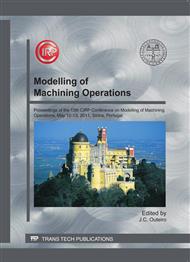[1]
F.W. Taylor: On the art of cutting metals, Transactions of the ASME, Vol. 28 (1907), p.31–350.
Google Scholar
[2]
S.A. Tobias, W. Fishwick: A Theory of Regenerative Chatter, The Engineer, London (1958).
Google Scholar
[3]
J. Tlusty, F. Koenigsberger: Machine Tool Structures, 5th Edition, Volume 1, Pergamon Press, Oxford (1970).
Google Scholar
[4]
H.E. Merritt: Transactions of the ASME – Journal of Engineering for Industry, Vol. 87 (1965), p.447–454.
Google Scholar
[5]
Y. Altintas, E. Budak: CIRP Annals – Manufacturing Technology, Vol. 44/1 (1995), p.357–362.
Google Scholar
[6]
Y. Altintas: JSME International Journal, Series C: Mechanical Systems, Machine Elements and Manufacturing, Vol. 44/3 (2001), p.717–723.
Google Scholar
[7]
F.J. Campa, L.N. Lopez de Lacalle, A. Lamikiz, J.A. Sanchez: Journal of Materials Processing Technology, Vol. 191/1–3 (2007), p.279–282.
Google Scholar
[8]
M.A. Davies, J.R. Pratt, B. Dutterer: CIRP Annals – Manufacturing Technology, Vol. 49/1 (2000), p.37–40.
Google Scholar
[9]
W.T. Corpus, W.J. Endres: American Society of Mechanical Engineers, Manufacturing Engineering Division, MED, Vol. 11 (2000), p.871–878.
Google Scholar
[10]
T. Insperger, G. Stepan: Periodica Polytechnica, Mechanical Engineering, Vol. 44/1 (2000), p.47–57.
Google Scholar
[11]
G. Stepan, R. Szalai, et al.: Transactions of the ASME – Journal of Vibration and Acoustic, Vol. 127/2 (2005), p.197–203.
Google Scholar
[12]
S.D. Merdol, Y. Altintas: Transactions of the ASME – Journal of Manufacturing Science and Engineering, Vol. 126/3 (2004), p.459–466.
Google Scholar
[13]
E. Budak, Y. Altintas: Transactions of the ASME – Journal of Dynamic Systems Measurement and Control, Vol. 120 (1998), p.22–30.
Google Scholar
[14]
M. Gadalla: Improving the Accuracy of Parametric Surfaces Using Cutting Force Synthesis and Surface Offset Techniques; Ph.D. Thesis, University of Western Ontario, Canada, (1997).
DOI: 10.1115/imece1997-1091
Google Scholar
[15]
S. Engin, Y. Altintas: American Society of Mechanical Engineers, Manufacturing Engineering Division, MED, Vol. 10 (1999), p.345–352.
Google Scholar
[16]
J. Gradisek, M. Kalveram, K. Weinert: International Journal of Machine Tools and Manufacture, Vol. 44/4 (2004), p.401–414.
Google Scholar
[17]
O.B. Adetoro, W.M. Sim, P.H. Wen: Machining Science and Technology, (at the press).
Google Scholar
[18]
O.B. Adetoro, W.M. Sim, P.H. Wen: Journal of Materials Processing Technology, Vol. 210/6-7 (2010a), p.969–979.
Google Scholar
[19]
O.B. Adetoro, W.M. Sim, P.H. Wen: The International Journal of Advanced Manufacturing Technology, 51/5-8 (2010b), p.453–466.
Google Scholar
[20]
V. Thevenot, L. Arnaud, G. Dessein, G. Cazenave–Larroche: Machining Science and Technology, Vol. 10 (2006), p.275–287.
DOI: 10.1080/10910340600902082
Google Scholar
[21]
S. Seguy, F.J. Campa, et al.: Toolpath: International Journal of Machining and Machinability of Materials, Vol. 4(4) (2008), p.377–392.
Google Scholar
[22]
O.B. Adetoro, P.H. Wen, W.M. Sim, R. Vepa: Engineering Letters, Vol. 17/4 (2009), p.257–265, (available at :http://www.engineeringletters.com/issues_v17/issue_4/EL_17_4_07. pdf).
Google Scholar
[23]
Lord Rayleigh: Theory of Sound, Vol. 2; The Macmillan Company, New York (1878) (Reprinted 1945 by Dover Publications, New York).
Google Scholar
[24]
T.K. Caughey, M.E.J. O'Kelly: Transactions of the ASME – Journal of Applied Mechanics, Vol. 27 (1960), p.269–271.
Google Scholar
[25]
R.G. Grimes, J.G. Lewis, H.D. Simon: SIAM Journal on Matrix Analysis and Applications, Vol. 15 (1994), p.228–272.
Google Scholar
[26]
Karlsson & Sorensen: Inc. Hibbitt, Abaqus Theory Manual, 1080 Main Street Pawtucket Rl 02860 – 4847 USA (2006).
Google Scholar


